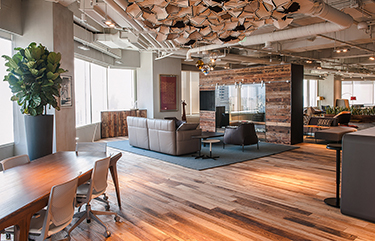|
Subscribe / Renew |
|
|
Contact Us |
|
| ► Subscribe to our Free Weekly Newsletter | |
| home | Welcome, sign in or click here to subscribe. | login |
Construction
| |
 |
March 29, 2018
How cleaner indoor air makes for healthy workers and a healthier bottom line
Glumac

Velkov
|
Walk into the 12,000-square-foot Haworth office and showroom in Shanghai and there is a lot to catch a visitor’s eye — panoramic city views, a mixture of open and wood-constructed drop ceilings, and of course the play area with a foosball table and Xbox. What may not draw immediate attention, though, is the three-stage air-filtration system, low-VOC materials and the rigorous attention given to air-quality monitoring.
“In China, people check the air quality the same way we check the weather in the U.S. — on a daily basis,” says Nicole Isle, Glumac’s chief sustainability strategist. “This is not a way to live. As we continue to urbanize, we need to remember to create humane spaces.”
Improving wellness
Glumac designed Haworth’s mechanical, electrical and plumbing systems under the Well Building Standard’s stringent air guidelines. Well focuses entirely on human health in seven categories: air, water, light, comfort, food, fitness and mind.
Haworth was the first Well-certified project in China, a country with some of the worst air quality in the world. However, Glumac is also supporting Well projects on the U.S. West Coast, and the trend of healthy buildings and good indoor air quality is spreading in the commercial sector.
Studies have shown that high-caliber indoor air — like that of the Haworth space and the Well standard — will effectively increase profits through increased productivity.
Take the 2016 Harvard University study on indoor air quality and cognitive function. Harvard took 24 office professionals and studied their typical work behavior for six days throughout a two-week timespan.
Unbeknownst to participants, researchers varied the air quality with outside air, recirculated air, off-gassing qualities and carbon dioxide concentrations. The levels of indoor air quality were placed into three categories: a typical building, a green building, and an enhanced green building. Participants then took a survey to assess their cognitive function.
On average, cognitive function scores were 61 percent higher in the green building and 101 percent higher in the enhanced green building over the baseline condition.
The biggest leg up in the green buildings came in the domains that required higher levels of cognitive processing: crisis response, information usage and information strategy.
This tells us that investments in good indoor air provide an ongoing return that makes the upfront investment in human-centric design well worth it.
“We’ve done all this work to create uber-energy-efficient, high-performance buildings,” Isle says.
“We’ve already figured that portion out. Now we’re talking about high-performance people. People are what make a business profitable or not. Spaces need to promote wellness and comfort to enliven people.”
Wellness in an office environment also comes with mechanical, electrical and plumbing systems that work in conjunction with biophilia. Biophilia is the practice of integrating nature into the built environment — literally the love of life.
This includes coupling indoor air quality with lighting that mimics human circadian rhythms, airflow that resembles an outdoor breeze, natural light and plants. The goal is to provide a healthy, humane environment that can actually speed up an owner’s return on investment.
“Whether you enjoy nature of not, the research is telling us that daily connections to nature boosts our health,” Isle says.
“Humans evolved outdoors, and our bodies remain very much in tune to outdoor conditions. When you rob someone of those conditions indoors, you rob them of their ability to sleep well at night, manage stress and feel energized.”
Glumac has supported many LEED platinum and gold projects in Seattle where productivity is key, including several Amazon offices, the Allen Institute for Brain Science, the Meridian Center for Health, and the University of Washington’s Mercer Court apartments. All included high levels of air quality considerations and, of course, high-efficiency systems.
Clean indoor air
Healthy indoor air can take many shapes. When mechanical engineers design systems for a Well or LEED platinum project, they increase the volume of fresh, outside air that enters a building, by typically about 30 percent above required standards.
Engineers can also increase air filtration, filtering air once when it comes into the building and again before it is recirculated. This helps to clean the air from any indoor particulate matter.
Finally, if owners want to go above and beyond in their efforts for good air quality, engineers can also design mechanical systems that incorporate an ultraviolet light. The process rids the air supply of bacteria, mold and viruses.
UV light is often used in the health care market. Now, it is becoming a topic of discussion for commercial buildings, as owners are increasingly interested in building-health conditions.
“If you can maintain the indoor air quality at a high level, minimize sick time, and make employees want to be in the space because it smells good and feels fresh, people will tend be more productive,” says Scott Vollmoeller, an executive vice president at Glumac.
“When an owner values human performance based on the built environment, and we can create the systems that support that, then we’ve done our job and we’ve done it well.”
Elena Velkov is a marketing specialist at Glumac’s Seattle office.
Other Stories:
- Let’s make buildings people can still use after a disaster
- New green rating systems go way beyond LEED
- Cheap solar energy won't end the need for deep-green buildings
- To meet green goals, cities must grow more strategically
- Asphalt: the go-to material for green paving projects
- Climate change is making resilience a more urgent design priority
- We designed our own net-zero office — and you can, too
- SPU remodel shows even industrial buildings can be green
- Why we can’t reach our emissions goals without tracking embodied carbon



